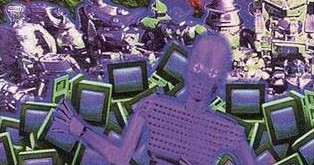|
[Close file]
Emails to the Editor:
Bozomatic Revisited
by Daniel Schneider
(comments and translation by Jens Kreutzer)
Daniel Schneider, current German Netrunner Champion, was kind enough to send me a few comments concerning the
last installment of "Famous Stacks", which was about Dennis Duncan's strategy "Bozomatic".
In the following, you can read a translation of Daniel's thoughts and my responses to them.
Daniel: I thought (once more) that the article on "Bozomatic" was not comprehensive enough, although the topic was a bit more
interesting in comparison to PB/TTC or Psycho Tycho. But then,
I have high standards. The introduction and motivation for the article were very good. However, I'd like to make the following
remarks/suggestions:
1) If I were you, I'd have explained "It is slow" more precisely. You list the cards that are part of the Runner setup, but I'd make it
clearer just how expensive all of this is: The 'breaker suite at 18 bits, five Clowns at another 20 bits, plus MUs for about 10 bits;
that's 48 bits already, without any cards for a winning strategy or defense! But even if you can pay for this installation, why is the
stack still slow? The answer: Because you don't seek out your 'breakers but install them as you draw them, and because there is only one of
each type. Running without a sentry 'breaker is too risky if you are short on protection cards while having a small hand size and valuable
cards you cannot afford to lose - and it can happen that you install the sentry 'breaker last, only after seven or nine turns!
Even if you are able to draw and install the 'breakers in a quick and optimized way, you cannot run without the Clowns and the rest of the
setup, because the 'breakers are too expensive to power up and the danger of taking damage (e. g., from a TRAP!) is too high. Therefore,
Bozomatic is almost always slow, no matter what your initial draw is like!
Ed.: I did briefly mention the high cost of the setup and the risk involved in early running, but you accurately pointed out some
deeper reasons for the deck's inherent slowness.
Daniel: 2) I wondered what you meant when you wrote that the drawing speed was "maximized" with Jack'n'Joe (JNJ) instead of with
Bodyweight Synthetic Blood (BSB), because that is not true. With a good bit engine, BSB is faster than JNJ. So, why use JNJ? Because the
second central thought with Bozomatic (next to the idea of building a stack that in principle consists only of programs) was to dispense
with the need of bit generation altogether! I thought that this should have been stressed more. After all, it's not just that Zetatech
Software Installers are used to install all programs, but also:
Edaemons are used instead of mem chips
EDennis dispensed with hand-size increasers
Ebecause unlike BSB, JNJ is free (and without hand size increasers, Dennis would overload his hand with BSB anyway)
Ebecause his winning strategy doesn't need any bits ("delivery of virus counters while running for free").
Ed.: Thank you for pointing this out. With "maximized", I meant "made as fast as possible, while taking into account the 0-bit-cost
philosophy of the deck", but I probably should have made that clearer. I was of course aware of the existence of BSB and its ability in
comparison to JNJ, just to reassure you. :-)
Daniel: 3) I somehow had the feeling that you didn't take Toughonium Wall into account, which is a piece of ice with strength 7
that is widely used and commonly encountered. Another twist with Bozomatic is, to wit, that you normally (without special enhancements)
get by with strength 6 versus sentries and 'gates, but need strength 7 versus walls!
Ed.: Oops! You are absolutely right - this hadn't occurred to me. So, with walls, you indeed have to expect ice with up to strength
7. My bad.
Daniel: 4) Have you taken a closer look at the strength issue, then? Like you said in the introduction, the 'breaker suite consists
of "0-to-break" icebreakers and a certain number of Clowns. But what are the reasons for the selection Dennis Duncan made? Wouldn't it be
a lot cheaper to take six instead of five Clowns while substituting Wild Card for Forward's Legacy, Codecracker for Wizard's Book and
perhaps even Jackhammer for Wrecking Ball, like you correctly hinted at in the beginning?
5) For what reasons have the other cards been included in "HyperClown"? One could analyze the strange-looking mixture of Imp, Afreet, and
Succubus for a start. And wherefore two Joan of Arc, for example? Isn't that a luxury, if you have to manage without other very important
cards (i. e., damage protection)? These are just a couple of thoughts that occurred to me.
Ed.: To be honest, my intention was mainly to showcase Dennis' stack, not to interpret it in detail. I am, however, quite impressed
by your insights, and although I cannot answer your questions at this point (we'd have to ask Dennis himself, I'd say), they might
spark a discussion. If Dennis himself or anyone else would like to comment on this, please send an Email
to the Editor, and it will most likely be published. As for the two Joans, this is what came to my mind: It certainly fits the theme
of an "all-programs" stack (disregarding preps) to take special care of programs, so that they won't ever get hurt. In that way, the stack
does have protection cards, if only for its biggest asset - programs.
[Neal's remarks to this Email to the Editor]
[Close file]
|
|
|

